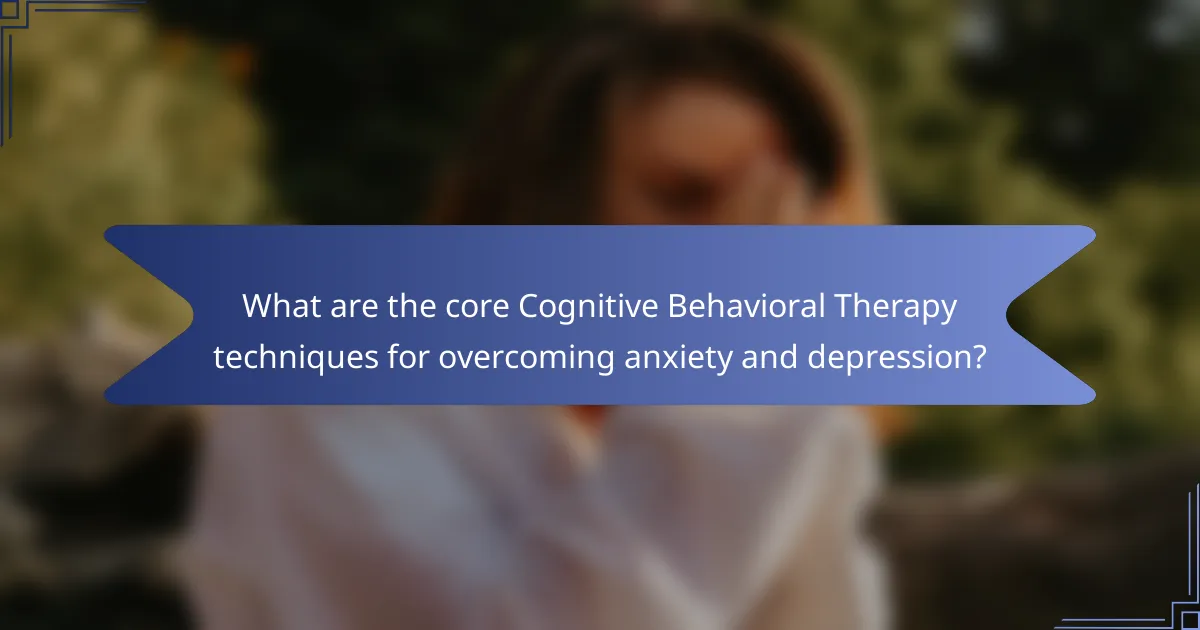Cognitive Behavioral Therapy (CBT) techniques effectively address anxiety and depression by helping individuals challenge negative thought patterns and confront fears. Key approaches include cognitive restructuring, exposure therapy, and behavioral activation. These techniques enhance self-awareness and emotional regulation, fostering resilience and long-term coping strategies. Research shows that 60-80% of individuals experience significant relief through structured CBT interventions.

What are the core Cognitive Behavioral Therapy techniques for overcoming anxiety and depression?
Cognitive Behavioral Therapy (CBT) techniques for overcoming anxiety and depression include cognitive restructuring, exposure therapy, behavioral activation, and mindfulness practices. These techniques help individuals identify and challenge negative thought patterns, gradually confront fears, increase engagement in positive activities, and enhance present-moment awareness. Each technique targets specific aspects of anxiety and depression, fostering resilience and emotional regulation.
How does Cognitive Behavioral Therapy address anxiety and depression?
Cognitive Behavioral Therapy (CBT) effectively addresses anxiety and depression by altering negative thought patterns. Techniques like cognitive restructuring help individuals identify and challenge distorted beliefs, leading to improved emotional regulation. Behavioral activation encourages engagement in enjoyable activities, reducing feelings of isolation. Mindfulness practices within CBT promote awareness of the present moment, decreasing anxiety symptoms. As a result, CBT equips individuals with practical tools to manage their mental health effectively.
What are the foundational principles of Cognitive Behavioral Therapy?
Cognitive Behavioral Therapy (CBT) is based on several foundational principles that guide its techniques for addressing anxiety and depression. These principles include the cognitive model, which posits that thoughts influence emotions and behaviors, enabling clients to identify and alter negative thought patterns. Another principle is the use of behavioral interventions, such as exposure therapy, which helps individuals confront and reduce their fears. Additionally, CBT emphasizes the importance of developing coping strategies and skills to manage stress and improve emotional regulation. These principles collectively support the effectiveness of CBT in fostering lasting change in mental health.
What role do thoughts play in Cognitive Behavioral Therapy?
Thoughts play a crucial role in Cognitive Behavioral Therapy (CBT) by influencing emotions and behaviors. CBT techniques focus on identifying and challenging negative thought patterns. This process helps individuals reframe their thinking, leading to reduced anxiety and depression symptoms. By addressing cognitive distortions, clients learn to replace harmful thoughts with more balanced perspectives. This shift not only improves emotional well-being but also promotes healthier coping strategies in daily life.
How do emotions influence behavior in Cognitive Behavioral Therapy?
Emotions significantly influence behavior in Cognitive Behavioral Therapy (CBT) by shaping thought patterns. CBT techniques help individuals identify and challenge negative emotions, leading to healthier behaviors. For example, cognitive restructuring allows clients to reframe distressing thoughts, promoting emotional regulation. As a result, this process reduces anxiety and depression symptoms, improving overall mental well-being.

What are the universal benefits of Cognitive Behavioral Therapy?
Cognitive Behavioral Therapy (CBT) offers universal benefits for managing anxiety and depression. It equips individuals with practical techniques to identify and challenge negative thought patterns, fostering healthier emotional responses.
CBT enhances self-awareness, enabling clients to recognize triggers and develop coping strategies. Research indicates that 60-80% of individuals experience significant symptom relief through CBT. Additionally, it promotes long-term resilience by teaching skills applicable beyond therapy sessions.
The structured nature of CBT allows for measurable progress, making it a preferred choice for many mental health professionals. Its adaptability to various formats, such as individual or group therapy, further broadens its accessibility.
How effective is Cognitive Behavioral Therapy for anxiety and depression?
Cognitive Behavioral Therapy (CBT) is highly effective for anxiety and depression. It equips individuals with practical skills to manage symptoms and alter negative thought patterns. Research indicates that approximately 60-70% of participants experience significant improvement after completing CBT. Techniques such as cognitive restructuring and exposure therapy are commonly employed, targeting specific anxiety triggers and depressive thoughts. Additionally, CBT’s structured approach allows for measurable progress over time, making it a preferred choice among mental health professionals.
What are the common techniques used in Cognitive Behavioral Therapy?
Cognitive Behavioral Therapy (CBT) employs various techniques to help individuals overcome anxiety and depression. Common techniques include cognitive restructuring, which challenges negative thought patterns; exposure therapy, gradually facing fears; behavioral activation, increasing engagement in positive activities; and mindfulness practices, promoting present-moment awareness. These methods aim to alter dysfunctional thinking and behavior, enhancing emotional regulation and coping strategies.
How does cognitive restructuring work?
Cognitive restructuring helps individuals identify and challenge negative thought patterns. This technique is essential in cognitive behavioral therapy for alleviating anxiety and depression. By recognizing distorted beliefs, clients can replace them with more balanced perspectives. As a result, emotional responses improve, leading to healthier coping mechanisms.
What is exposure therapy and how is it applied?
Exposure therapy is a cognitive behavioral technique used to help individuals confront and reduce anxiety by gradually exposing them to feared situations or stimuli. This method is applied through a structured process that typically involves identifying triggers, creating a hierarchy of fears, and systematically facing them in a controlled environment.
The therapy aims to desensitize patients to their fears, allowing them to engage with previously avoided situations. Research indicates that exposure therapy can significantly decrease symptoms of anxiety disorders, including phobias and PTSD. As a result, it is a core component of cognitive behavioral therapy strategies for overcoming anxiety and depression.

What unique techniques differentiate Cognitive Behavioral Therapy from other therapies?
Cognitive Behavioral Therapy (CBT) employs techniques that focus on identifying and changing negative thought patterns, setting it apart from other therapies. Key techniques include cognitive restructuring, exposure therapy, and behavioral activation. Cognitive restructuring helps clients challenge distorted beliefs, while exposure therapy gradually confronts fears. Behavioral activation encourages engagement in meaningful activities, combating depression. These distinct approaches enable CBT to effectively address anxiety and depression through structured, goal-oriented interventions.
How does the behavioral activation approach function?
The behavioral activation approach functions by encouraging individuals to engage in activities that promote positive emotions and reduce avoidance behaviors. This technique helps combat anxiety and depression by identifying and scheduling enjoyable or meaningful activities.
Key components include assessing current behaviors, recognizing patterns that contribute to emotional distress, and gradually increasing engagement in rewarding activities. As a result, individuals experience improved mood and motivation, reinforcing a cycle of positive behavior.
What is the significance of cognitive distortions in treatment?
Cognitive distortions play a crucial role in treatment by identifying and challenging negative thought patterns. They contribute to anxiety and depression, making recognition essential for effective cognitive behavioral therapy. By addressing these distortions, patients can reframe their thoughts, leading to improved emotional well-being. This process enhances the therapeutic relationship and fosters resilience, ultimately promoting long-term recovery.

What are the rare but notable techniques in Cognitive Behavioral Therapy?
Cognitive Behavioral Therapy (CBT) employs several rare techniques that can effectively address anxiety and depression. Notable methods include exposure therapy, which gradually exposes individuals to feared stimuli, and cognitive restructuring, which challenges negative thought patterns. Another unique approach is mindfulness-based cognitive therapy, integrating mindfulness practices to enhance emotional regulation. Additionally, schema therapy focuses on identifying and altering deep-seated cognitive schemas that contribute to emotional distress. These techniques, while less common, can significantly improve therapeutic outcomes for those struggling with anxiety and depression.
How is schema therapy integrated into Cognitive Behavioral Therapy?
Schema therapy enhances Cognitive Behavioral Therapy (CBT) by addressing deep-rooted patterns and emotional responses. It incorporates techniques such as schema identification and cognitive restructuring to help clients recognize and modify maladaptive beliefs. This integration allows for a more comprehensive treatment of anxiety and depression by targeting both surface symptoms and underlying issues. As a result, clients experience improved emotional regulation and healthier coping strategies.
What role does acceptance and commitment therapy play in Cognitive Behavioral Therapy?
Acceptance and Commitment Therapy (ACT) enhances Cognitive Behavioral Therapy (CBT) by promoting psychological flexibility. ACT focuses on accepting thoughts and feelings rather than avoiding them, which complements CBT’s emphasis on changing negative thought patterns. This integration helps individuals confront anxiety and depression more effectively. Research shows that combining ACT with CBT techniques can lead to improved outcomes in emotional regulation and overall mental health. By fostering acceptance, individuals can engage more fully in their lives, aligning actions with personal values.

How can Cognitive Behavioral Therapy be adapted for different cultural contexts?
Cognitive Behavioral Therapy (CBT) can be adapted for different cultural contexts by integrating culturally relevant practices and beliefs. This ensures that therapy resonates with clients’ values and experiences.
Cultural adaptation may involve modifying language, examples, and metaphors used in therapy. For instance, therapists can incorporate local idioms or narratives that reflect clients’ cultural backgrounds.
Furthermore, understanding cultural stigma around mental health can shape how CBT techniques are introduced. This awareness helps build trust and encourages open communication during therapy sessions.
Lastly, therapists should consider unique cultural attributes, such as collectivism versus individualism, which influence how clients perceive and respond to anxiety and depression.
What considerations should be made for diverse populations in therapy?
Diverse populations in therapy require cultural sensitivity and tailored approaches. Therapists should consider language barriers, cultural beliefs, and socioeconomic factors. Understanding unique backgrounds enhances trust and efficacy in cognitive behavioral therapy techniques. Incorporating community resources can further support diverse clients in overcoming anxiety and depression.

What are the best practices for implementing Cognitive Behavioral Therapy techniques?
To effectively implement Cognitive Behavioral Therapy techniques, focus on structured approaches. Start with identifying negative thought patterns and challenging them with evidence-based reasoning. Incorporate behavioral experiments to test the validity of these thoughts. Regular practice of mindfulness can enhance emotional regulation, while goal-setting facilitates motivation. Lastly, maintain a consistent review of progress to adapt strategies as necessary.
What common mistakes should be avoided in Cognitive Behavioral Therapy?
Avoiding common mistakes in Cognitive Behavioral Therapy (CBT) is crucial for effective treatment. Key mistakes include neglecting to set specific goals, failing to challenge negative thoughts, and not practicing techniques outside sessions. Additionally, therapists may overlook the importance of building a therapeutic alliance, which can hinder progress. Regularly reviewing and adjusting treatment plans is essential to address individual needs effectively.
How can individuals maximize the effectiveness of Cognitive Behavioral Therapy techniques?
To maximize the effectiveness of Cognitive Behavioral Therapy techniques, individuals should actively engage in practice and self-reflection. Consistency in applying techniques like cognitive restructuring and exposure therapy enhances results.
Additionally, setting specific, measurable goals fosters motivation and accountability. Tracking progress through journals can identify patterns and reinforce positive changes. Seeking feedback from a therapist provides valuable insights, helping to tailor techniques to personal needs.
Incorporating mindfulness practices can further enhance the benefits of CBT by promoting present-moment awareness and reducing anxiety. Regularly reviewing and adjusting strategies ensures continued effectiveness in overcoming anxiety and depression.